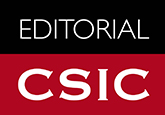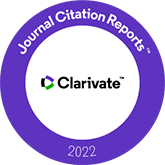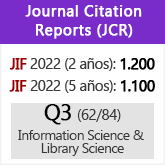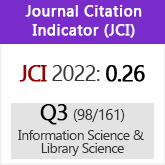Modelizando el uso de las bibliotecas públicas a través de sus características: estudio comparativo entre España y Finlandia para los préstamos y las visitas
DOI:
https://doi.org/10.3989/redc.2018.4.1544Palabras clave:
Bibliotecas públicas, uso de bibliotecas, modelos, análisis de regresión lineal múltiple, paso a paso, préstamos, visitas, España, FinlandiaResumen
El objetivo de este artículo es la modelización del uso de las bibliotecas públicas comparando los casos de España y Finlandia. Se analiza la relación a nivel de municipios entre una serie de factores tomados como características propias de las bibliotecas (presupuesto, personal, colección, etc.) y el uso de las mismas (préstamos y visitas). En un análisis por regiones, se consideran también variables del contexto socioeconómico (renta, educación, desempleo). El método para la obtención de los modelos es el análisis de regresión lineal múltiple con la técnica paso a paso. En España, los modelos a nivel de municipios explicaron el 16,8% de los préstamos y el 17,7% de las visitas, mientras que en Finlandia explicaron el 23% y el 18% respectivamente. Por tanto, para ambos países más del 75% de la variación de los préstamos y las visitas depende de otros factores no contemplados en los modelos. A nivel de regiones, ninguna de las variables del entorno socioeconómico consideradas como añadidas respecto al análisis por municipios resultó significativa. La limitación principal del estudio es la falta de datos a nivel de municipios para las variables del entorno socioeconómico consideradas en el análisis por regiones. En cuanto al valor y su originalidad, este estudio puede ser considerado como uno de los primeros sobre modelización del uso de las bibliotecas públicas españolas y también como uno de los primeros en poner en relación los resultados con otro país, en este caso Finlandia.
Descargas
Citas
Aabo, S.; Audunson, R. (2012). Use of library space and the library as place. Library & Information Science Research, 34 (2), 138-149. https://doi.org/10.1016/j.lisr.2011.06.002
Aabo, S.; Audunson, R.; Varheim, A. (2010). How do public libraries function as meeting places? Library & Information Science Research, 32 (1), 16-26. https://doi.org/10.1016/j.lisr.2009.07.008
BOE. (2017). Código de Legislación Bibliotecaria. Selección y ordenación: ANABAD. Códigos Electrónicos. Boletín Oficial del Estado. [En línea]. Disponible en: http://www.boe.es/legislacion/codigos/abrir_pdf. php?fich=024_Codigo_de_Legislacion_Bibliotecaria. pdf [Fecha de consulta: 18/09/2018].
Burke, S. K. (2007). The use of public libraries by native Americans. Library Quarterly, 77 (4), 429-461. https://doi.org/10.1086/520998
Carrión-Gútiez, A. (2013). Informe de situación de las bibliotecas públicas españolas en 2012. El Profesional de la Información, 22 (3), 250-258. https://doi.org/10.3145/epi.2013.may.09
Chen, P.; Rea, C.; Shaw, R.; Bottino, C. J. (2016). Associations between Public Library Use and Reading Aloud among Families with Young Children. Journal of Pediatrics, 173, 221-227. https://doi.org/10.1016/j.jpeds.2016.03.016 PMid:27056451
CIS. (2014). Barómetro de diciembre 2014. Estudio nº 3047. Centro de Investigaciones Sociológicas. [En línea]. Disponible en: http://www.cis.es/cis/export/ sites/default/-Archivos/Marginales/3040_3059/3047/ es3047mar.html [Fecha de consulta: 18/09/2018].
CIS. (2016). Barómetro de junio 2016. Estudio nº 3142. Centro de Investigaciones Sociológicas. [En línea]. Disponible en: http://www.cis.es/cis/export/sites/default/- Archivos/Marginales/3140_3159/3142/Es3142mar. html [Fecha de consulta: 18/09/2018].
Creaser, C.; Sumsion, J. (1995). Affluence and public library use: The DoE Index of Local Conditions and library use in London and the metropolitan districts of England. Library Management, 16 (6), 3-15. https://doi.org/10.1108/01435129510091793
D'Elia, G.; Jörgensen, C.; Woelfel, J.; Rodger, E. J. (2002). The impact of the Internet on public library use: An analysis of the current consumer market for library and Internet services. Journal of the American Society for Information Science and Technology, 53 (10), 802- 820. https://doi.org/10.1002/asi.10102
Delgado-López-Cozar, E. (2002). La investigación en biblioteconomía y documentación. Trea, Gijón, España.
Fernández-Ardèvol, M.; Ferran-Ferrer, N.; Nieto-Arroyo, J.; Fenoll, C. (2018). The public library as seen by the non-users. El profesional de la información, 27 (3), 659-670. https://doi.org/10.3145/epi.2018.may.19
Ferran-Ferrer, N.; Guallar, J.; Abadal, E.; Server, A. (2017). Research methods and techniques in Spanish library and information science journals (2012-2014). Information Research, 22 (1). http://www.informationr.net/ir/22-1/paper741.html
Gould, E.; Gomez, R. (2010). New challenges for libraries in the information age: a comparative study of ICT in public libraries in 25 countries. Information Development, 26 (2), 166-176. https://doi.org/10.1177/0266666910367739
Guallar, J.; Ferran-Ferrer, N.; Abadal, E.; Server, A. (2017). Library and information science journals in Spain: Thematic and methodological analysis. El Profesional de la Información, 26 (5), 947-960. https://doi.org/10.3145/epi.2017.sep.16
Hair, J. F.; Black, W. C.; Babin, B. J.; Anderson, R. E. (2010). Multivariate Data Analysis (7.ª ed.). Upper Saddle River, New Jersey: Prentice-Hall Inc.
Herrera-Viedma, E.; López-Gijón, J. (2013). Libraries' social role in the information age. Science, 339 (6126), 1382. https://doi.org/10.1126/science.339.6126.1382-a PMid:23520092
Houghton, K.; Foth, M.; Miller, E. (2013). The continuing relevance of the library as a third place for users and non-users of IT: the case of Canada Bay. The Australian Library Journal, 62 (1), 27-39. https://doi.org/10.1080/00049670.2013.771764
Huysmans, F; Hillebrink, C. (2008). The future of the Dutch public library: ten years on. The Hague, The Netherlands: Netherlands Institute for Social Research. PMCid:PMC2492876
Ignatow, G. (2011). What has globalization done to developing countries' public libraries? International Sociology, 26 (6), 746-768. https://doi.org/10.1177/0268580910393373
Ignatow, G.; Webb, S. M.; Poulin, M.; Parajuli, R.; Fleming, P.; Batra, S.; Neupane, D. (2012). Public Libraries and Democratization in Three Developing Countries: Exploring the Role of Social Capital. Libri, 62 (1), 67-80. https://doi.org/10.1515/libri-2012-0005
INE. (2018). Instituto Nacional de Estadística. [En línea]. Disponible en: http://www.ine.es/ [Fecha de consulta: 18/09/2018].
Japzon, A. C.; Gong, H. (2005). A neighborhood analysis of public library use in New York City. Library Quarterly, 75 (4), 446-463. https://doi.org/10.1086/502786
Johnson, C. A.; Griffis, M. R. (2014). The effect of public library use on the social capital of rural communities. Journal of Librarianship and Information Science, 46 (3), 179-190. https://doi.org/10.1177/0961000612470278
Jorgensen, C.; D'Elia, G.; Woelfel, J.; Rodger, E. (2001). The impact of the Internet on public library use: Current status and trends for the future. Proceedings of the ASIST Annual Meeting, 38, 141-155.
Keshvari, M.; Farashbandi, F. Z.; Geraei, E. (2015). Modelling influential factors on customer loyalty in public libraries: a study of West Iran. Electronic Library, 33 (4), 810-823. https://doi.org/10.1108/EL-10-2013-0185
Kim, G.; Yu, S. Y. (2011). An Exploratory Study to Develop an Alternative Model of Public Library Management Using the Institute of Museum and Library Services' Public Library Statistics. Library Quarterly, 81 (4), 359-382. https://doi.org/10.1086/661656
Kishida, K. (1998). A mathematical model on public library loan incorporating an inverse size effect. Library and Information Science, (40), 29-35.
Koontz, C. M.; Jue, D. K.; Lance, K. C. (2005). Neighborhood-based in-library use performance measures for public libraries: A nationwide study of majority-minority and majority white/low income markets using personal digital data collectors. Library and Information Science Research, 27 (1), 28-50. https://doi.org/10.1016/j.lisr.2004.09.003
Lai, H.-J.; Wang, C.-Y. (2012). Examining public librarian's information literacy, self-directed learning readiness, and e-learning attitudes: A study from Taiwan. Malaysian Journal of Library & Information Science, 17 (2), 101-115.
Lara, L. S.; Stilwell, C.; Underwood, P. G. (2015). Correlations between the economy and public library use. Bottom Line, 28 (1-2), 26-33.
Lázaro-Rodríguez, P.; López-Gijón, J.; Alonso, S.; Martínez-Sánchez, M.Á.; Herrera-Viedma, E. (2018a). Secaba-Rank, herramienta online para analizar y evaluar bibliotecas. El profesional de la información, 27 (2), 278-288. https://doi.org/10.3145/epi.2018.mar.06
Lázaro-Rodríguez, P; López-Gijón, J; Herrera-Viedma, E. (2018b). Visibilidad de las bibliotecas públicas y la lectura en medios de comunicación españoles frente a otros hechos de la cultura y relación con su uso: medidas para su mayor promoción y difusión. BiD: textos universitaris de biblioteconomia i documentació, 40 (juny).
Lin, H.; Pang, N.; Luyt, B. (2015). Is the library a third place for young people? Journal of Librarianship and Information Science, 47 (2), 145–155. https://doi.org/10.1177/0961000614532303
Mäkinen, I. (2001). The golden age of Finnish public libraries: institutional, structural and ideological background since the 1960's. En: Mäkinen, Ilkka (editor) Finnish public libraries in the 20th century, pp. 116- 150. Tampere, Finland: Tampere University Press.
McClure, C. R.; Bertot, J. C. (1998). Public Library Use in Pennsylvania: Identifying Uses, Benefits, and Impacts. Final Report. Harrisburg, Pennsylvania: Pennsylvania State Dept. of Education.
MECD. (2015). Encuesta de Hábitos y Prácticas Culturales 2014-2015. Ministerio de Educación, Cultura y Deporte. [En línea]. Disponible en: http://es.calameo.com/ read/0000753358b572c390560 [Fecha de consulta: 18/09/2018].
MECD. (2018a). Bibliotecas públicas españolas en cifras. Ministerio de Educación, Cultura y Deporte. [En línea]. Disponible en: http://www.mecd.gob.es/cultura-mecd/areas-cultura/bibliotecas/mc/ebp/portada.html [Fecha de consulta: 18/09/2018].
MECD. (2018b). Base Estadísticas Educación. Ministerio de Educación, Cultura y Deporte. [En línea]. Disponible en: https://www.educacion.gob.es/educabase/menu.do?type=pcaxis&path=/Formacionyml/ EPA2016/NivFor&file=pcaxis&l=s0 [Fecha de consulta: 18/09/2018].
Obokoh, N. P.; Arokoyu, S. B. (1991). The influence of geographical location on public library use: a case study from a developing country. Bulletin - Special Libraries Association, Geography & Map Division, 163, 30-42.
Sanderson, C. R. (1950). The Library's Public: A Report of the Public Library Inquiry. Bernard Berelson. The Library Quarterly, 20 (1), 47-49. https://doi.org/10.1086/617605
Sei-Ching, J. S; Kyung-Sun, K. (2008). Use and non-use of public libraries in the information age: A logistic regression analysis of household characteristics and library services variables. Library & Information Science Research, 30 (3), 207-215. https://doi.org/10.1016/j.lisr.2007.11.008
Sei-Ching, J. S; Vakkari, P. (2015). Perceived outcomes of public libraries in the U.S. Library & Information Science Research, 37 (3), 209-219. https://doi.org/10.1016/j.lisr.2015.04.009
Smith, I. M. (1999). What do we know about public library use? Aslib Proceedings, 51 (9), 302-314. https://doi.org/10.1108/EUM0000000006990
Statfin. (2018). Statistics Finland's PX-Web databases. [En línea]. Disponible en: http://pxnet2.stat.fi/PXWeb/ pxweb/en/StatFin/ [Fecha de consulta: 18/09/2018].
Sumsion, J.; Hawkins, M.; Morris, A. (2002). The economic value of book borrowing from public libraries - An optimisation model. Journal of Documentation, 58 (6), 662- 682. https://doi.org/10.1108/00220410210448200
SYKT. (2018). Suomen yleisten kirjastojen tilastot - Finnish Public Libraries Statistics Database. [En línea]. Disponible en: http://tilastot.kirjastot.fi/index. php?lang=en [Fecha de consulta: 18/09/2018].
Uddin, M. N.; Quaddus, M.; Islam, M. S. (2006). Socio-economic-cultural aspects and mass information need: The case of public library uses in Bangladesh. Library Management, 27 (9), 636-652. https://doi.org/10.1108/01435120610715536
Vakkari, P. (2012). Internet use increases the odds of using the public library. Journal of Documentation, 68 (5), 618- 638. https://doi.org/10.1108/00220411211256003
Vakkari, P. (2014). Models explaining the perceived outcomes of public libraries. Journal of Documentation, 70 (4), 640-657. https://doi.org/10.1108/JD-02-2013-0016
Vakkari, P.; Aabø, S.; Audunson, R.; Huysmans, F.; Kwon, N.; Oomes, M.; Sin, S.-C. J. (2016). Patterns of perceived public library outcomes in five countries. Journal of Documentation, 72 (2), 342-361. https://doi.org/10.1108/JD-08-2015-0103
Vakkari, P.; Aabø, S.; Audunson, R.; Huysmans, F.; Oomes, M. (2014). Perceived outcomes of public libraries in Finland, Norway and the Netherlands. Journal of Documentation, 70 (5), 927–944. https://doi.org/10.1108/JD-06-2013-0072
Van-Ryzin, G. G.; Charbonneau, E. (2010). Public service use and perceived performance: an empirical note on the nature of the relationship. Public Administration, 88 (2), 551-563. https://doi.org/10.1111/j.1467-9299.2010.01820.x
Whitacre, B.; Rhinesmith, C. (2015). Public libraries and residential broadband adoption: Do more computers lead to higher rates? Government Information Quarterly, 32 (2), 164-171. https://doi.org/10.1016/j.giq.2015.02.007
Yilmaz, B. (1998). A sociological study of public library use in Ankara, Turkey. Journal of Librarianship and Information Science, 30 (4), 259-267. https://doi.org/10.1177/096100069803000406
Publicado
Cómo citar
Número
Sección
Licencia
Derechos de autor 2018 Consejo Superior de Investigaciones Científicas (CSIC)

Esta obra está bajo una licencia internacional Creative Commons Atribución 4.0.
© CSIC. Los originales publicados en las ediciones impresa y electrónica de esta Revista son propiedad del Consejo Superior de Investigaciones Científicas, siendo necesario citar la procedencia en cualquier reproducción parcial o total.Salvo indicación contraria, todos los contenidos de la edición electrónica se distribuyen bajo una licencia de uso y distribución “Creative Commons Reconocimiento 4.0 Internacional ” (CC BY 4.0). Puede consultar desde aquí la versión informativa y el texto legal de la licencia. Esta circunstancia ha de hacerse constar expresamente de esta forma cuando sea necesario.
No se autoriza el depósito en repositorios, páginas web personales o similares de cualquier otra versión distinta a la publicada por el editor.

















